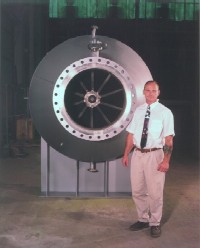The Worlds First Detonation Flame Arrester Designs. We Specialize in detonation flame arresters, deflagration and in-line flame arresters!
Our staff has been developing detonation flame arrester technology since 1989, not only have we designed some of the very first detonation flame arresters in the world, but were also instrumental in participating in the writing of the strict safety standards that set the bar by which detonation flame arresters of today are gauged and built.
We started out as a research and development and testing laboratory, licensing and selling technology to manufacturers and industry. After filing a number of patents on detonation flame arresters over a twenty year period, Dwight Brooker, inventor and the founder of Paradox, decided that manufacturing was the next logical move for corporate growth and new challenges.
We started out as a research and development and testing laboratory, licensing and selling technology to manufacturers and industry. After filing a number of patents on detonation flame arresters over a twenty year period, Dwight Brooker, inventor and the founder of Paradox, decided that manufacturing was the next logical move for corporate growth and new challenges.
Why Detonation Flame Arresters

Meeting increasingly stringent federal, state, and local air quality regulations and complying with higher safety standards requires advanced technological solutions.
Paradox Intellectual Properties Inc. provides quality products in the design, patent, testing and manufacture of Flame Arresters, to meet the technological challenges of environmental and safety standards. Our staff have been leading the effort in meeting these environmental technological challenges since 1989.
Detonation Flame Arrester products were created in response to environmental regulations (such as The Clean Air Act) which required liquid product storage terminals and hydrocarbon processing plants to control evaporation hydrocarbon emissions from loading and storage operations In 1989 this new regulations now required the recovery of gaseous vapors and their incineration necessary. This is a required alternative to the practice of venting gases into the atmosphere. Incineration and vapor recovery, however, create greater safety risks. Companies that engage in this operation have critical safety concerns. In systems containing flammable liquid and vapor products, protection against flashback is vital as conditions exist for potential detonations.
This process is called vapor control. Two types of recognized vapor control technologies are commonly used; carbon adsorption vapor recovery and vapor destruction or combustion. Vapor destruction systems include elevated flare systems, enclosed flare systems, burner and catalytic incineration systems, and waste gas boilers. Both systems require flame or detonation flame arresters to maximize safety. Detonation flame arresters are used in many industries, including refining, pharmaceutical, chemical, and petrochemical, pulp and paper, oil exploration and production, sewage treatment, landfills, mining, power generation, and bulk liquids transportation.
Flame arresters are passive devices with no moving parts. They prevent the propagation of flame from the exposed side of the unit to the protected side by the use of metal matrix creating a torturous path called a flame cell or element. All detonation flame arresters operate on the same principle: removing heat from the flame as it attempts to travel through narrow passages with walls of metal or other heat-conductive material, but unlike flame arresters, detonation flame arresters must be built to withstand extreme pressures that travel at supersonic velocities, 1,500 psia @ 2500 m/sec is not uncommon with a group D Gas.
Our Tested and proven Detonation Flame Arrester designs currently provide the maximum flame arrestment protection and reliability and are economically priced. Paradox Detonation Flame Arresters have been accepted by the U.S. Coast Guard, the benchmark of U.S. performance standards, for use in Marine Terminals. We currently have 96 US Coast Guard approved models, more than any other US company. Overall, Paradox has more than 200 flame arrester models for various applications and gas groups, including hydrogen.
Our unique design features allow for larger flame channels that require less maintenance and provide greater ease in cleaning when service is needed. Paradox Detonation Flame Arresters are bi-directional and built to withstanding both low and high pressure deflagrations as well as stable and overdriven detonations. The Group “D” element is rated a Type I for flame stabilization with an initial operating pressure of 22.7 psia.
Detonation Flame Arresters are installed in a variety of systems such as;
- Storage tank facilities
- Offshore drilling and production platforms Oil/petrochemical refineries
- Chemical processing plants
- Pulp and paper plants
- Pharmaceutical manufacturing facilities Natural gas supply lines
- Flare stacks
- Vapor Control Systems
- Vapor incineration systems
- vapor recovery systems
- Landfill gas incineration
- Sewage treatment vapor processing
Check out our "PRODUCTS" page for detailed information on our flame arrester products.
